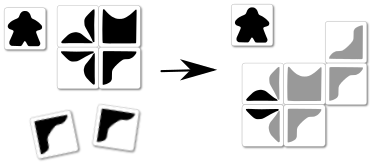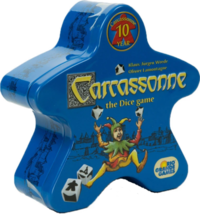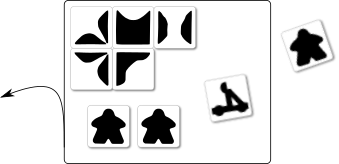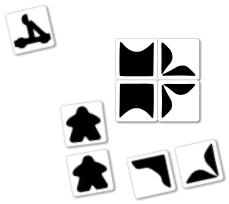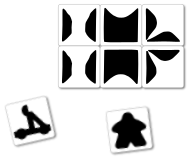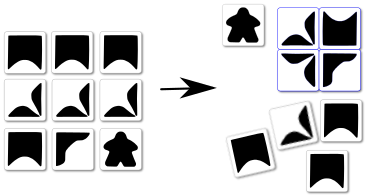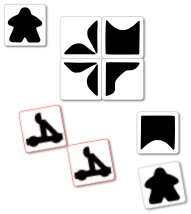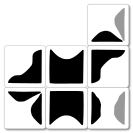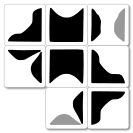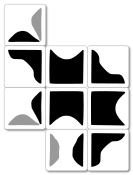The Dice Game
General info and comments
This is the official dice game for Carcassonne. A game for 2-5 players released as part of the 10th anniversary of Carcassonne by Hans im Glück in 2011. Designed by Olivier Lamontagne and Klaus-Jürgen Wrede.
Contents
The game comes in a metal meeple shaped box that contains:
- 9 Carcassonne six-sided dice with the following faces:
- 4 city segments
- 1 knight
- 1 catapult
- 1 pad
- 1 pencil
Overview
In the Carcassonne dice game, the players cleverly use dice rolls to try to build closed cities as large as they can -the bigger, the better.
Rules
Playing the game
The players roll the dice in turn order. The player choose a start player who begins and takes all 9 dice. On a player's turn, he rolls dice up to 3 times and then scores his result (see scoring section). He then passes the dice to his left neighbor, who continues the game.
A player rolls all the dice before him on his first roll. If he rolls 1 or more catapults the player passes those dice immediately to the player to his left (he may not re-roll the catapults nor score points for this roll).
When a player rolls knights and city segments, he may set them aside or re-roll them as he chooses. When a player sets city segment aside, he must immediately build a city with them. The player may not rebuild already built city segments. Knights, once set aside, may not be re-rolled.
If a player collects 3 or more knights, he may choose not to score this turn and then double his score for the next turn. He keeps 1 knight and passes all other dice to his left neighbor. In his next turn, the player adds the knight die to the dice passed to him and rolls them. Thus, each player may have a knight, reducing the dice for others.
City building
The player tries to build as large a city as possible with the dice he rolls. During the scoring, he scores the number of dice in his largest city.
City building rules
- The black parts are the city segments.
- Black parts are played next to black parts and white parts next to white parts.
- Once a die is used to build, it may not be re-rolled.
Scoring
After a player has rolled 3 times or chooses not to roll again, he may score his turn. The rules for scoring are:
- Only the dice of the largest closed city are scored (if the player did not build a closed city, he scores no points).
- If the player had a knight at the beginning of his turn, he scores double the points.
- The points are recording on the score pad.
- The points are scored as follows:
- 3 dice = 1 point
- 4 dice = 3 points
- 5 dice = 6 points
- 6 dice = 10 points
- 7 dice = 15 points
- 8 dice = 21 points
- 9 dice = 28 points
Game end
As soon as a player has scored 42 total points, the game ends and that player is the winner.
Special case: if a player rolls 9 catapults during his turn, he wins immediately, regardless of the points he scored so far in the game.
Additional information
This section extends the basic information provided in the rules.
Detailed turn example
This example provides additional details about the impossibility of moving the dice placed as city or re-rolling knights.
